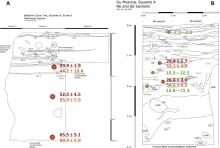Reliable chronologies are essential for understanding the timing and routes of human dispersal through Southeast Asia, both of which remain open questions. This study provides luminescence chronologies for two archaeological sites in Myanmar—Badahlin Cave and Gu Myaung Cave—from which Palaeolithic artefacts have been recovered. We applied single-grain post-infrared infrared stimulated luminescence (pIRIR) and multi-grain infrared-radiofluorescence (IR-RF) dating methods to potassium-rich feldspar (K-feldspar) grains extracted from the sedimentary deposits at these two sites. Luminescence characteristics of the K-feldspar extracts showed that the procedures were well suited for dating. The single-grain pIRIR ages suggest human occupation of Badahlin and Gu Myaung Caves by ∼30 ka and ∼25 ka, respectively, although the age estimates for Gu Myaung Cave are much older than the radiocarbon ages. The ages obtained using the IR-RF signal are even older, which we attribute to insufficient bleaching of this signal—and perhaps also the pIRIR signal—and the probable existence of a substantial residual dose at the time of sediment deposition.
First luminescence ages for Myanmar
Schaarschmidt, M., Fu, X., Li, B., Marwick, B., Khaing, K., Douka, K., & Roberts, R. G. 2019 pIRIR and IR-RF dating of archaeological deposits at Badahlin and Gu Myaung Caves–First luminescence ages for Myanmar. Quaternary Geochronology 49, 262-270
View PDF
(952.16 KB)
